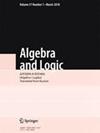可划分刚性群。Morley等级
IF 0.6
3区 数学
Q4 LOGIC
引用次数: 0
摘要
本文章由计算机程序翻译,如有差异,请以英文原文为准。
Divisible Rigid Groups. Morley Rank
Let G be a countable saturated model of the theory 𝔗m of divisible m-rigid groups. Fix the splitting G1G2 . . .Gm of a group G into a semidirect product of Abelian groups. With each tuple (n1, . . . , nm) of nonnegative integers we associate an ordinal α = ωm−1nm+ . . . + ωn2 + n1 and denote by G(α) the set \( {G}_1^{n_1}\times {G}_2^{n_2}\times \dots \times {G}_m^{n_m} \), which is definable over G in \( {G}^{n_1+\dots +{n}_m} \). Then the Morley rank of G(α) with respect to G is equal to α. This implies that RM (G) = ωm−1 + ωm−2 + . . . + 1.
求助全文
通过发布文献求助,成功后即可免费获取论文全文。
去求助
来源期刊

Algebra and Logic
数学-数学
CiteScore
1.10
自引率
20.00%
发文量
26
审稿时长
>12 weeks
期刊介绍:
This bimonthly journal publishes results of the latest research in the areas of modern general algebra and of logic considered primarily from an algebraic viewpoint. The algebraic papers, constituting the major part of the contents, are concerned with studies in such fields as ordered, almost torsion-free, nilpotent, and metabelian groups; isomorphism rings; Lie algebras; Frattini subgroups; and clusters of algebras. In the area of logic, the periodical covers such topics as hierarchical sets, logical automata, and recursive functions.
Algebra and Logic is a translation of ALGEBRA I LOGIKA, a publication of the Siberian Fund for Algebra and Logic and the Institute of Mathematics of the Siberian Branch of the Russian Academy of Sciences.
All articles are peer-reviewed.
 求助内容:
求助内容: 应助结果提醒方式:
应助结果提醒方式:


